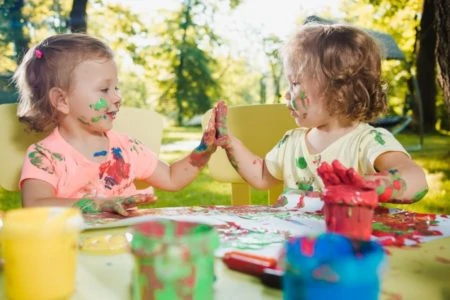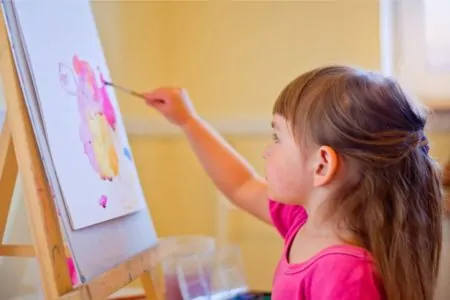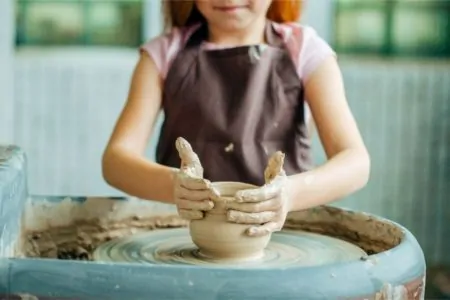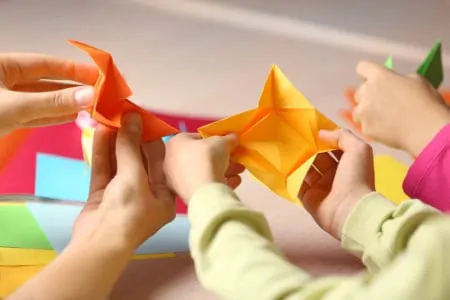Child development experts generally agree on four main stages of artistic growth. We will break down exactly what to look for, when these milestones usually happen, and how you can support your budding Picasso along the way.
4 Key Stages in Drawing
Most experts rely on the work of Viktor Lowenfeld, a creative education professor who defined the standard stages of artistic development. While every kid is unique, these stages give you a roadmap for what happens between ages 1 and 8.
1. Disordered Scribbling
Age: 1-2 years
Welcome to the beginning. This stage, often called “random scribbling,” usually starts right after the first birthday. At this point, your toddler isn’t trying to draw a cat; they are just realizing that moving their arm makes a mark on the paper.
It is purely a kinesthetic activity. They swing their arm, enjoy the motion, and likely look away while they do it. The scribbles are erratic, often going off the page (RIP to your table). It is all about motor coordination and cause and effect, not self-expression just yet.
2. Controlled Scribbling
Age: 2-3 years
Around age two, a lightbulb goes on. The child discovers a link between their hand movements and the marks appearing on the page. This is a huge leap in fine motor control.
You will notice smaller, more repetitive motions like circles, swirls, or vertical lines. They might start experimenting with different colors or holding the crayon differently.
Towards the end of this stage, you enter “Named Scribbling.” This is when your toddler points to a blob of purple circles and confidently says, “This is Daddy.” It might not look like Daddy, but the intent is there. They have shifted from enjoying the motion to symbolic thinking.
3. The Preschematic Stage
Age: 3-4 years
This is where things get really fun. The “Preschematic” stage marks the first attempt at drawing recognizable shapes like circles, squares, and crosses.
The most famous creation during this time is the “Tadpole Person.” It is usually a large circle (the head) with two lines sticking out (legs) and maybe some arms coming out of the ears. To a child, the head is the most important part of the body, so it gets the most space.
They aren’t worried about realistic proportions or spatial awareness yet. Objects might float randomly around the page, and colors are often chosen based on preference rather than reality (hello, blue dogs).
4. The Schematic Stage
Age: 5-6+ years
By kindergarten or first grade, children enter the “Schematic” stage. They now have a set formula (or schema) for drawing specific things. A house might always be a square with a triangle roof, and a flower is always a circle with loops.
You will see the emergence of the “groundline.” Instead of floating in space, people and trees now stand on a green line at the bottom of the paper, with a blue sky line at the top.
Drawings become more detailed. People get fingers, hair, eyelashes, and clothes. They might also draw “X-ray” pictures, like seeing the furniture inside a house even though the outside walls are drawn. This shows they are thinking conceptually about what is inside an object, not just what is visible.
Why Is Art Important in a Child’s Development?
Art isn’t just about pretty pictures; it is a powerhouse for brain development. It builds the neural connections needed for writing, reading, and emotional regulation.
- Fine Motor Skills: Gripping a crayon promotes the dexterity needed to hold a pencil and write letters later in school.
- Emotional Processing: Drawing gives children a safe outlet to express feelings they might not have the vocabulary for yet.
- Decision Making: Choosing where to put a line or which color to use builds critical thinking and planning skills.
- Visual-Spatial Skills: Learning to interpret 2D images helps with reading and navigating the physical world.
It is important to focus on the process, not the product. If we focus too much on the final result, kids can get discouraged. Letting them experiment freely builds confidence and creativity.
How to Encourage Children to Draw
Some kids grab a marker and never look back, while others need a little nudge. We cannot force creativity, but we can set the stage for it. Here are ten ways to encourage your child to create.
- Prioritize process over product: Instead of saying “What is it?”, try describing what you see. Say, “I love how you used bright yellow here!” or “Look at those big swirls.” This validates their effort without pressure.
- Make art accessible: Keep a “creation station” available where kids can grab paper and crayons whenever inspiration strikes. If they have to ask for supplies every time, they are less likely to draw.
- Draw side-by-side: Sit down and doodle with them. But be careful not to make your drawings too “perfect.” If you draw a realistic horse, they might feel intimidated. Keep your drawings simple and silly to show that art is for everyone.
- Mix up the medium: Bored of paper? Let them draw with chalk on the driveway, paint on snow, or use bath crayons in the tub. Novelty keeps the brain engaged.
- Try mess-free options: If you are avoiding cleanup, tools like the Aqua Doodle Mat allow kids to draw with just water (no stains!), while a Magnetic Drawing Board is perfect for travel and endless erasing.
- Visit galleries (or scroll them): Take a trip to a museum, or just look at art books from the library. Seeing different styles shows them there is no “right” way to draw.
- Respect their autonomy: Let them draw the sky green and the grass purple. Correcting their “mistakes” kills creativity. They are building their own world; let them rule it.
- Explore textures: Tape sandpaper to the table and color on it, or draw on aluminum foil. The different sensory feedback is great for sensory seekers.
- Don’t force it: If they aren’t interested right now, back off. Forcing art makes it a chore. They might prefer building blocks or clay, which are also artistic!
- Use their interests: If they are obsessed with dinosaurs, get a dinosaur coloring book or ask them to draw a T-Rex eating a pizza. Connect art to what they already love.
FAQs
In Conclusion
Every scribbled page is a stepping stone in your child’s development. Whether they are currently in the chaotic scribble phase or drawing detailed family portraits with floating heads, they are hard at work building their brain.Keep the paper handy, ignore the mess when you can, and enjoy the view of the world through their eyes.









